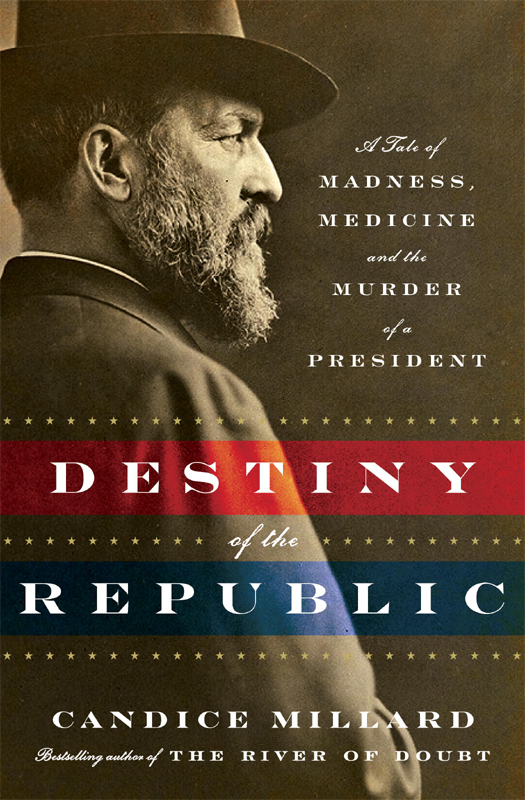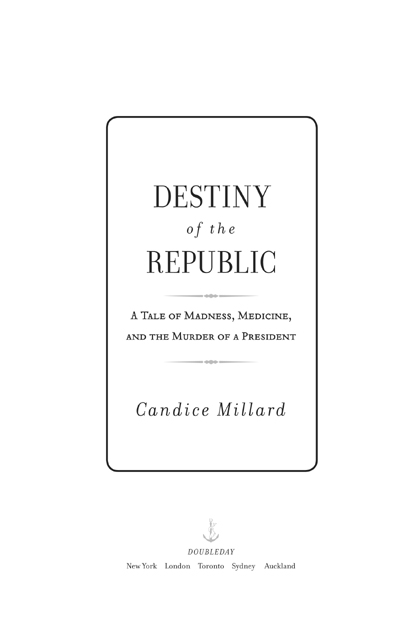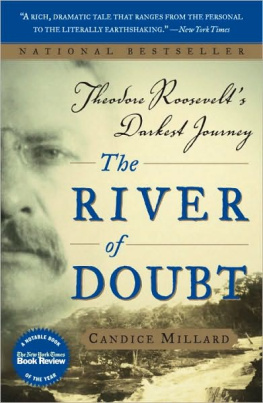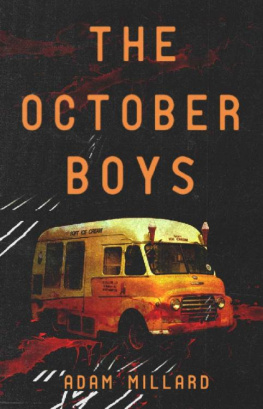Candice Millard - Destiny of the Republic: A Tale of Madness, Medicine and the Murder of a President
Here you can read online Candice Millard - Destiny of the Republic: A Tale of Madness, Medicine and the Murder of a President full text of the book (entire story) in english for free. Download pdf and epub, get meaning, cover and reviews about this ebook. year: 2011, publisher: Doubleday, genre: Non-fiction. Description of the work, (preface) as well as reviews are available. Best literature library LitArk.com created for fans of good reading and offers a wide selection of genres:
Romance novel
Science fiction
Adventure
Detective
Science
History
Home and family
Prose
Art
Politics
Computer
Non-fiction
Religion
Business
Children
Humor
Choose a favorite category and find really read worthwhile books. Enjoy immersion in the world of imagination, feel the emotions of the characters or learn something new for yourself, make an fascinating discovery.

- Book:Destiny of the Republic: A Tale of Madness, Medicine and the Murder of a President
- Author:
- Publisher:Doubleday
- Genre:
- Year:2011
- Rating:5 / 5
- Favourites:Add to favourites
- Your mark:
- 100
- 1
- 2
- 3
- 4
- 5
Destiny of the Republic: A Tale of Madness, Medicine and the Murder of a President: summary, description and annotation
We offer to read an annotation, description, summary or preface (depends on what the author of the book "Destiny of the Republic: A Tale of Madness, Medicine and the Murder of a President" wrote himself). If you haven't found the necessary information about the book — write in the comments, we will try to find it.
Destiny of the Republic: A Tale of Madness, Medicine and the Murder of a President — read online for free the complete book (whole text) full work
Below is the text of the book, divided by pages. System saving the place of the last page read, allows you to conveniently read the book "Destiny of the Republic: A Tale of Madness, Medicine and the Murder of a President" online for free, without having to search again every time where you left off. Put a bookmark, and you can go to the page where you finished reading at any time.
Font size:
Interval:
Bookmark:

Also by Candice Millard
The River of Doubt: Theodore Roosevelts Darkest Journey

Copyright 2011 by Candice Millard
All rights reserved. Published in the United States by Doubleday, a division of Random House, Inc., New York, and in Canada by Random House of Canada Limited, Toronto.
www.doubleday.com
DOUBLEDAY and the portrayal of an anchor with a dolphin are registered trademarks of Random House, Inc.
constitute an extension of this copyright page.
Jacket design by John Fontana
Jacket photograph courtesy of the Library of Congress
Library of Congress Cataloging-in-Publication Data
Millard, Candice.
Destiny of the republic : a tale of madness, medicine, and the murder of a president / Candice Millard.1st ed.
p. cm.
1. Garfield, James A. (James Abram), 18311881Assassination. 2. PresidentsUnited StatesBiography. 3. Guiteau, Charles Julius, 18411882. 4. PresidentsMedical careUnited StatesHistory
19th century. 5. MedicineUnited StatesHistory19th century. 6. Bell, Alexander Graham, 18471922. 7. Medical instruments and apparatusUnited StatesHistory19th century. 8. United StatesPolitics and government18811885. 9. Political cultureUnited StatesHistory19th century. 10. Power (Social sciences)United StatesHistory19th century. I. Title.
E687.9.M55 2011
973.84092dc22 2011001549
eISBN: 978-0-385-53500-7
v3.1
For my parents,
Lawrence and Constance Millard,
on their fiftieth wedding anniversary
PROMISE

WAR

FEAR

TORTURED FOR THE REPUBLIC

C HOSEN
C rossing the Long Island Sound in dense fog just before midnight on the night of June 11, 1880, the passengers and crew of the steamship Stonington found themselves wrapped in impenetrable blackness. They could feel the swell of the sea below them, and they could hear the low-slung ship plowing through the water, its enormous wooden paddle wheels churning, its engine drumming. At steady intervals, the blast of the foghorn reverberated through the darkness, but no ship returned its call. They seemed to be utterly alone.
Although most of the passengers had long since retired to private cabins or the bright warmth of the saloon, one man stood quietly on the deck, peering into the fog that obscured everything beyond his own pale hands. At five feet seven inches tall, with narrow shoulders, a small, sharp face, and a threadbare jacket, Charles Guiteau was an unremarkable figure. He had failed at everything he had tried, and he had tried nearly everything, from law to ministry to even a free-love commune. He had been thrown in jail. His wife had left him. His father believed him insane, and his family had tried to have him institutionalized. In his own mind, however, Guiteau was a man of great distinction and promise, and he predicted a glorious future for himself.
Just three days earlier, immediately following the Republican Partys tumultuous presidential convention in faraway Chicago, Guiteau had decided to pack his few belongings and leave Boston, his sights set on the partys campaign headquarters in New York. In a surprise nomination, James Garfield, an eloquent congressman from Ohio, had been chosen over a field of powerful contenders, including even former president Ulysses S. Grant. Like Guiteau, Garfield had started out with very little in life, but where Guiteau had found failure and frustration, Garfield had found unparalleled success. The excitement surrounding the unexpected, charismatic candidate was palpable, and Guiteau was determined to be a part of it.
Absorbed in his own thoughts, and blinded by the thick fog that blanketed the sound, Guiteau did not even see the other ship until it was too late. One moment there was the soft, rhythmic splashing of the paddle wheels. In the next instant, before Guiteaus eyes, a 253-foot steamship abruptly materialized from the darkness and collided with Guiteaus ship head-on in a tremendous, soul-wrenching crash of iron and steel. As the Stonington recoiled from the blow and tried to pull astern, it compounded the disaster by tearing away the starboard wheelhouse and wheel of the oncoming shipits sister steamer, the Narragansett, which had been headed at full speed in the opposite direction.
On board the Narragansett, passengers were suddenly plunged into darkness, confusion, and terror. As the ship listed steeply, the lights went out and rushing water and scalding steam poured over the decks. Several staterooms were swept away entirely, and one man, who had been asleep in an upper bunk, was thrown out of a gaping hole and into the sound. Just as the shocked passengers, who had rushed from their rooms in nightgowns and bare feet, began to comprehend what had happened, another thunderous blast shook the Narragansett as its boiler, which had been struck by the Stonington, exploded. Flames licked the well-oiled decks, sending a deadly firestorm billowing through the ship.
As the passengers of the Stonington watched in horror, the men and women of the Narragansett, frantic to escape the fire, began to throw themselves and their children over the sides of the blazing ship into the depths of the sound. One terrified young man raised his gun and shot himself as the boat began to sink. In just minutes, the fire grew in intensity until it covered the length of the ship, from stem to stern, and illuminated the sound for miles.
As the tragedy unfolded before him, Guiteau could hear the screams and desperate cries for help, which continued, disembodied, even after the ship burned to the waterline and then sank, plunging the shell-shocked witnesses, once again, into complete darkness. The frightened and ill-prepared crew of the Stonington lowered lifeboats into the water and circled blindly for hours, searching for survivors by their cries and pulling them to safety by arms, legs, clothing, even the hair of their heads. Many, however, had already drowned, or had drifted beyond help, their cries fading as they were carried away by the tide.
When the Stonington finally staggered into its home port in Connecticut early on the morning of June 12, the towns stunned inhabitants were met with a scene of destruction that, in the words of one reporter, beggar[ed] description. The ships bow had been smashed in, the timber and planking ripped away nearly to the waterline. Three passengers of the Narragansett who had been rescued from the sound had already died on board. Twenty-seven more had burned to death or drowned. Those who had survived collapsed on the pier, hysterical, nearly naked, their skin left in shreds by the fire. Parents searched frantically for children as crew members solemnly wrapped two bodies, that of a man and a child, in sailcloth and laid them upon rocks near the shore. Two weeks later another body would wash up on Fishers Island.
Font size:
Interval:
Bookmark:
Similar books «Destiny of the Republic: A Tale of Madness, Medicine and the Murder of a President»
Look at similar books to Destiny of the Republic: A Tale of Madness, Medicine and the Murder of a President. We have selected literature similar in name and meaning in the hope of providing readers with more options to find new, interesting, not yet read works.
Discussion, reviews of the book Destiny of the Republic: A Tale of Madness, Medicine and the Murder of a President and just readers' own opinions. Leave your comments, write what you think about the work, its meaning or the main characters. Specify what exactly you liked and what you didn't like, and why you think so.




